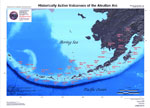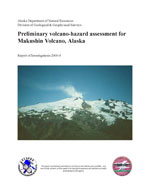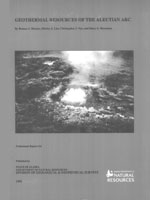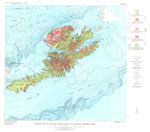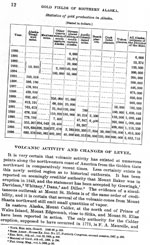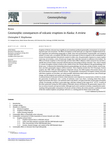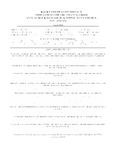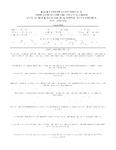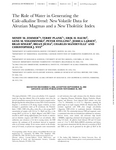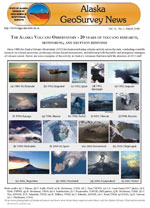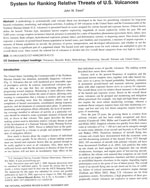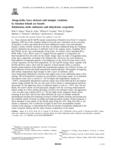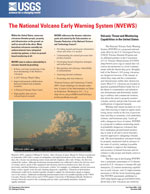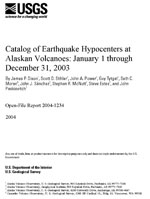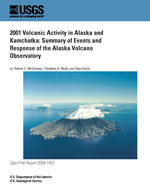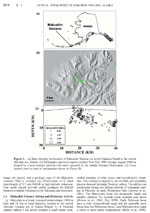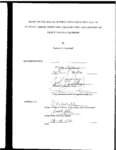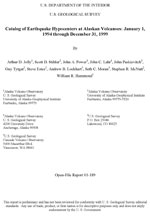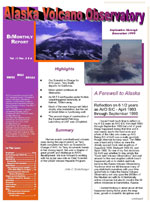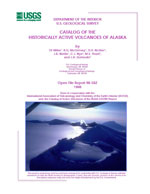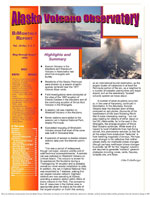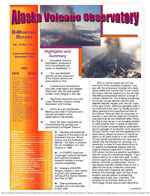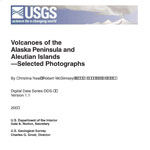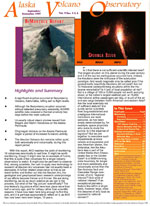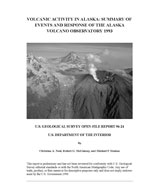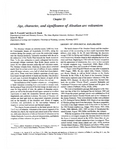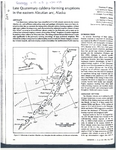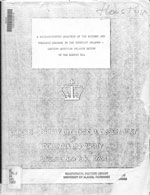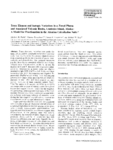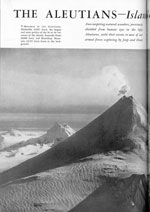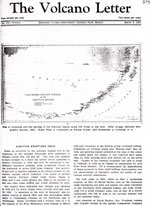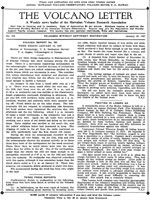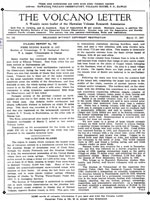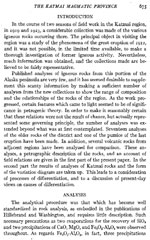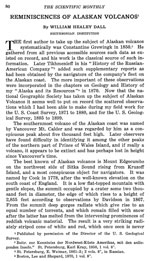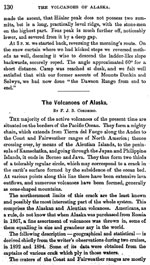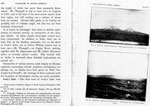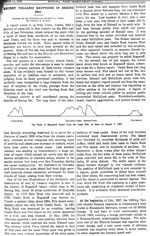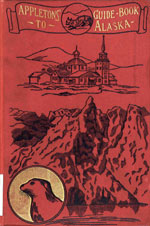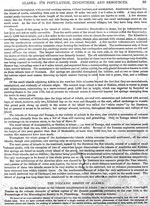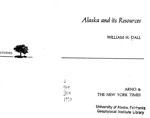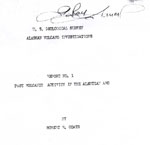References
Wang, J., Lu, Z., Gregg, P.M., and Kim, J.-W., 2024, Evolution of the magma system at Makushin volcano, Alaska, from 2004 to 2021: Journal of Volcanology and Geothermal Research v. 446, 107991. https://doi.org/10.1016/j.jvolgeores.2023.107991
Cheng, Y., and Grapenthin, R., 2024, The Alaska Makushin Volcano 2016–2018 inflation and its potential relation to the 2020 earthquake swarm, from GNSS observations: Journal of Volcanology and Geothermal Research in press, 108010. https://doi.org/10.1016/j.jvolgeores.2024.108010
Orr, T., Cameron, C.E., Dietterich, H.R., Loewen, M.W., Lopez, T., Lyons, J.J., Nakai, J., Power, J.A., Searcy, C., Tepp, G., and Waythomas, C.W., 2024, 2020 Volcanic activity in Alaska - Summary of events and response of the Alaska Volcano Observatory: U.S. Geological Survey Scientific Investigations Report 2024-5004, 34 p. https://doi.org/10.3133/sir20245004.
Wang, J., 2024, Deformation mapping and modeling of the Aleutian volcanoes with InSAR and numerical models: University Park, Tex., Southern Methodist University, Ph.D. dissertation, 143 p.
Mallalieu, J., Barr, I.D., Spagnolo, M., Mullan, D.J., Symeonakis, E., Edwards, B.R., and Martin, M.D., 2024, Proximity to active volcanoes enhances glacier velocity: Communications Earth & Environment v. 5, 679. https://doi.org/10.1038/s43247-024-01826-5
Cameron, C.E., Bull, K.F., and Macpherson, A.E., 2023, Recently active volcanoes of Alaska: Alaska Division of Geological & Geophysical Surveys Miscellaneous Publication 133 v. 6, 2 sheets. https://doi.org/10.14509/31086.
Lubbers, J., Loewen, M., Wallace, K., Coombs, M., and Addison, J., 2023, Probabilistic source classification of large tephra producing eruptions using supervised machine learning - an example from the Alaska-Aleutian Arc: Geochemistry, Geophysics, Geosystems v. 24, no. 11, e2023GC011037. https://doi.org/10.1029/2023GC011037.
Wang, J., Lu, Z., Bekaert, D., Marshak, C., Govorcin, M., Sangha, S., Kennedy, J., and Gregg, P., 2023, Along-arc volcanism in the western and central Aleutian from 2015 to 2021 revealed by cloud-based InSAR processing: Geophysical Research Letters v. 50, no. 23, e2023GL106323. https://doi.org/10.1029/2023GL106323
Jean, M., Perfit, M., and Anonymous, 2023, Plutonic rocks drilled beneath Makushin Volcano, Unalaska Island; a mashed view of the Aleutian Islands [abs.]: Geological Society of America Abstracts with Programs v. 55, no. 4, p. 28-8. https://doi.org10.1130/abs/2023CD-387082
Alaska Volcano Observatory, National Oceanic and Atmospheric Administration, National Weather Service, Federal Aviation Administration, Department of Defense, United States Coast Guard, Division of Homeland Security and Emergency Management, Alaska Department of Environmental Conservation, and Alaska Department of Health and Social Services (participating agencies), 2022, Alaska interagency operating plan for volcanic ash episodes, 85 p.
Waythomas, C.F., 2022, Selected crater and small caldera lakes in Alaska: Characteristics and hazards: Frontiers in Earth Science, v. 9, p. 23, doi:10.3389/feart.2021.751216.
Lanza, F., Roman, D.C., Power, J.A., Thurber, C.H., and Hudson, T., 2022, Complex magma-tectonic interactions during the 2020 Makushin Volcano, Alaska earthquake swarm: Earth and Planetary Science Letters, v. 587, https://doi.org/10.1016/j.epsl.2022.117538.
Konstantinou, K.I., 2022, Multiyear temporal variation of b-values at Alaskan volcanoes: The synergetic influence of stress and material homogeneity: Journal of Volcanology and Geothermal Research, v. 427, p. 13., doi.org/10.1016/j.jvolgeores.2022.107572.
Cameron, C.E., Crass, S.W., and AVO Staff, eds, 2022, Geologic database of information on volcanoes in Alaska (GeoDIVA): Alaska Division of Geologic and Geophysical Surveys Digital Data Series 20, https://doi.org/10.14509/geodiva, https://doi.org/10.14509/30901.
Reath, K., Pritchard, M.E., Roman, D.C., Lopez, T., Carn, S., Fischer, T.P., Lu, Z., Poland, M.P., Vaughan, R.G., Wessels, R., Wike, L.L., and Tran, H.K., 2021, Quantifying eruptive and background seismicity, deformation, degassing, and thermal emissions at volcanoes in the United States during 1978-2020: Journal of Geophysical Research: Solid Earth, v. 126, e2021JB021684, doi: 10.1029/2021JB021684.
Power, J.A., Haney, M.M., Botnick, S.M., Dixon, J.P., Fee, David, Kaufman, A.M., Ketner, D.M., Lyons, J.J., Parker, Tom, Paskievitch, J.F., Read, C.W., Searcy, Cheryl, Stihler, S.D., Tepp, Gabrielle, and Wech, A.G., 2020, Goals and development of the Alaska Volcano Observatory seismic network and application to forecasting and detecting volcanic eruptions: Seismological Research Letters, doi: 10.1785/0220190216 .
Schaefer, J.R.G., Perreault, J.M., Larsen, J.F., and Vallance, J.W., 2020, Makushin Volcano ash hazards: Alaska Division of Geological & Geophysical Surveys Information Circular 86, 2 p., http://doi.org/10.14509/30411.
Lanza, Federica, Thurber, C.H., Syracuse, E.M., Power, J.A., and Ghosh, Abhijit, 2020, Seismic tomography of compressional wave velocity and attenuation structure for Makushin Volcano, Alaska: Journal of Volcanology and Geothermal Research, doi:10.1016/j.jvolgeores.2020.106804
Cameron, C.E., Schaefer, J.R., and Ekberg, P.G., 2020, Historically active volcanoes of Alaska: Alaska Division of Geological & Geophysical Surveys Miscellaneous Publication 133 v. 4, 2 sheets. Http://doi.org/10.14509/30426
Werner, Cynthia, Kern, Christoph, and Kelly, P.J., 2020, Chemical evaluation of water and gases collected from hydrothermal systems located in the central Aleutian arc, August 2015: U.S. Geological Survey Scientific Investigations Report 2020-1029, 35 p., https://doi.org/10.3133/sir20201029.
Plank, T., Rasmussen, D., Stelling, P., and Roman, D., 2020, Field report for the collection of mafic tephra from the Aleutian Islands between Unimak and the Islands of Four Mountains (Alaska, USA), version 1.0: Interdisciplinary Earth Data Alliance (IEDA), https://doi.org/10.26022/IEDA/111584. Accessed 2020-06-25.
Cameron, C.E., Dixon, J.P., Waythomas, C.F., Iezzi, A.M., Wallace, K.L., McGimsey, R.G., and Bull, K.F., 2020, 2016 Volcanic activity in Alaska-Summary of events and response of the Alaska Volcano Observatory: U.S. Geological Survey Scientific Investigations Report 2020-5125, 63 p., https://doi.org/10.3133/sir20205125.
Dixon, J.P., Cameron, C.E., Iezzi, A.M., Power, J.A., Wallace, K., and Waythomas, C.F., 2020, 2017 Volcanic activity in Alaska-Summary of events and response of the Alaska Volcano Observatory: U.S. Geological Survey Scientific Investigations Report 2020-5102, 61 p., https://doi.org/10.3133/sir20205102.
Lerner, A.H., O'Hara, D., Karlstrom, L., Ebmeier, S.K., Anderson, K.R., and Hurwitz, S., 2020, The prevalence and significance of offset magma reservoirs at arc volcanoes: Geophysical Research Letters, v. 47, doi:10.1029/2020GL087856.
Lerner, A.H., 2020, The depths and locations of magma reservoirs and their consequences for the behavior of sulfur and volcanic degassing: University of Oregon Ph.D. thesis, 378 p. Available at https://search.proquest.com/openview/cec1ff16af338dce2495b5a1a491aa88/1?pq-origsite=gscholar&cbl=44156.
Larsen, J.F., Schaefer, Janet, Vallance, J.W., and Neill, O.K., 2020, Petrology and geochemistry of three Early Holocene eruptions from Makushin Volcano, Alaska: Bulletin of Volcanology, v. 82, n. 72, 17 p., doi:10.1007/s00445-020-01412-5.
Xue, Xueming, and Freymueller, J.T., 2020, A 25‐year history of volcano magma supply in the east central Aleutian arc, Alaska: Geophysical Research Letters, v. 47, no. 15, 7 p., https://doi.org/10.1029/2020GL088388.
Plank, T., Rasmussen, D. J., Stelling, P., and Roman, D. C., 2020, Field report for the collection of mafic tephra from the Aleutians Islands between Unimak and the Island of Four Mountains (Alaska, USA), version 1.0: Interdisciplinary Earth Data Alliance (IEDA). https://doi.org/10.26022/IEDA/111584
Dixon, J.P., Stihler S.D., Haney, M.M., Lyons, J.J., Ketner, D.M., Mulliken, K.M., Parker, T., and Power, J.A., 2019, Catalog of earthquake parameters and description of seismograph and infrasound stations at Alaskan volcanoes - January 1, 2013, through December 31, 2017: U.S. Geological Survey Data Series 1115, 92 p., https://doi.org/10.3133/ds1115.
Power, J.A., Friberg, P.A., Haney, M.M., Parker, T., Stihler, S.D., and Dixon, J.P., 2019, A unified catalog of earthquake hypocenters and magnitudes at volcanoes in Alaska—1989 to 2018: U.S. Geological Survey Scientific Investigations Report 2019–5037, 17 p., https://doi.org/10.3133/sir20195037.
Rasmussen, D.J., and Plank, T.A., 2019, Bulk rock data for the central-eastern Aleutian volcanoes, version 1.0: Interdisciplinary Earth Data Alliance (IEDA). https://doi.org/10.26022/IEDA/111870
Mulliken, K.M., Schaefer, J.R., and Cameron, C.E., 2018, Geospatial distribution of tephra fall in Alaska: a geodatabase compilation of published tephra fall occurrences from the Pleistocene to the present: Alaska Division of Geological & Geophysical Surveys Miscellaneous Publication 164, 46 p. http://doi.org/10.14509/29847
Mulliken, K.M., 2018, The Alaska Volcano Observatory: 30 years of protecting Alaskans from the effects of volcanic activity (1988-2018): Alaska Division of Geological & Geophysical Surveys Information Circular 67, 2 p. http://doi.org/10.14509/30032
Lerner, A.H., Crowley, P.D., Nicolaysen, K.P., and Hazlett, R.W., 2018, Stratigraphy, distribution, and evidence for mafic triggering of the ca. 8.5 ka Driftwood Pumice eruption, Makushin Volcano, Alaska, U.S.A.: Journal of Volcanology and Geothermal Research, v. 357, p. 362-377, https://doi.org/10.1016/j.jvolgeores.2018.05.006 .
Prejean, S.G., and Hill, D.P., 2018, The influence of tectonic environment on dynamic earthquake triggering: a review and case study on Alaskan volcanoes: Tectonophysics, v. 745, p. 293-304, doi.org/10.1016/j.tecto.2018.08.007.
Worden, A.K., Schaefer, J.R., and Mulliken, K.M., 2018, Tephra occurrence in Alaska: a map-based compilation of stratigraphic tephra data: Alaska Division of Geological and Geophysical Surveys Miscellaneous Publication 165, 19 p., http://doi.org/10.14509/30059
Ewert, J.W., Diefenbach, A.K., and Ramsey, D.W., 2018, 2018 update to the U.S. Geological Survey national volcanic threat assessment: U.S. Geological Survey Scientific Investigations Report 2018-5140, 40 p., https://pubs.usgs.gov/sir/2018/5140/sir20185140.pdf.
Cameron, C.E., Schaefer, J.R., and Mulliken, K.M., 2018, Historically active volcanoes of Alaska: Alaska Division of Geological & Geophysical Surveys Miscellaneous Publication 133 v. 3, 2 sheets. Http://doi.org/10.14509/30142
Barr, I.D., Lynch, C.M., Mullan, Donal, De Siena, Luca, and Spagnolo, Matteo, 2018, Volcanic impacts on modern glaciers: a global synthesis: Earth-Science Reviews, v. 182, p. 186-203, doi: http://dx.doi.org/10.1016/j.earscirev.2018.04.008.
Cameron, C.E., and Schaefer, J.R., 2016, Historically active volcanoes of Alaska: Alaska Division of Geological & Geophysical Surveys Miscellaneous Publication 133 v. 2, 1 sheet, scale 1:3,000,000. http://doi.org/10.14509/20181
Cameron, C.E., and Snedigar, S.F., 2016, Alaska Volcano Observatory image database: Alaska Division of Geological & Geophysical Surveys Digital Data Series 13, https://www.avo.alaska.edu/images/. https://doi.org/10.14509/29689.
Waythomas, C.F., 2015, Geomorphic consequences of volcanic eruptions in Alaska: A review: Geomorphology, v. 246, p. 123-145, doi: 10.1016/j.geomorph.2015.06.004
Dixon, J.P., Cameron, Cheryl, McGimsey, R.G., Neal, C.A., and Waythomas, Chris, 2015, 2013 Volcanic activity in Alaska - Summary of events and response of the Alaska Volcano Observatory: U.S. Geological Survey Scientific Investigations Report 2015-5110, 92 p., http://dx.doi.org/10.3133/sir20155110.
Cai, Yue, Rioux, Mtthew, Kelemen, P.B., Goldstein, S.L., Bolge, Louise, and Kylander-Clark, A.R.C., 2015, Distinctly different parental magmas for calc-alkaline plutons and tholeiitic lavas in the central and eastern Aleutian arc: Earth and Planetary Science Letters, v. 431. p. 119 - 126, doi:10.1016/j.epsl.2015.07.058
Syracuse, E.M., Maceira, M., Zhang, H., and Thurber, C.H., 2015, Seismicity and structure of Akutan and Makushin Volcanoes, Alaska, using joint body and surface wave tomography: Journal of Geophysical Research Solid Earth, v. 120, p. 1036-1052.
Schaefer, J.R., Cameron, C.E., and Nye, C.J., 2014, Historically active volcanoes of Alaska: Alaska Division of Geological & Geophysical Surveys Miscellaneous Publication 133 v. 1.2, 1 sheet, scale 1:3,000,000.
This publication has been superseded. Newest version available at http://www.dggs.alaska.gov/pubs/id/20181 .
Buurman, Helena, Nye, C.J., West, M.E., and Cameron, Cheryl, 2014, Regional controls on volcano seismicity along the Aleutian Arc: Geochemistry, Geophysics, Geosystems, doi:10.1002/2013GC005101
Neal, C.A., Herrick, J., Girina, O.,A., Chibisova, M., Rybin, A., McGimsey, R.G., and Dixon, J., 2014, 2010 Volcanic activity in Alaska, Kamchatka, and the Kurile Islands - Summary of events and response of the Alaska Volcano Observatory: U.S. Geological Survey Scientific Investigations Report 2014-5034, 76 p., http://dx.doi.org/10.3133/sir20145034 .
Cameron, C.E., and Nye, C.J., 2014, Preliminary database of Quaternary vents in Alaska: Alaska Division of Geological & Geophysical Surveys Miscellaneous Publication 153, 11 p., doi:10.14509/27357 .
Lu, Zhong, and Dzurisin, Daniel, 2014, InSAR imaging of Aleutian volcanoes: Chichester, UK, Springer-Praxis, 390 p.
Dixon, J.P., Stihler, S.D, Power, J.A., Haney, Matt, Parker, Tom, Searcy, C.K., and Prejean, Stephanie, 2013, Catalog of earthquake hypocenters at Alaskan volcanoes: January 1 through December 31, 2012: U.S. Geological Survey Data Series 789, 84 p., available at http://pubs.usgs.gov/ds/789/ .
Dixon, J.P., Stihler, S.D., Power, J.A., and Searcy, C.K., 2012, Catalog of earthquake hypocenters at Alaskan volcanoes: January 1 through December 31, 2011: U.S. Geological Survey Data Series 730, 82 p., available online at http://pubs.usgs.gov/ds/730/pdf/ds730.pdf .
Ruppert, N.A., Kozyreva, N.P., and Hansen, R.A., 2012, Review of crustal seismicity in the Aleutian Arc and implications for arc deformation: Tectonophysics, v. 522-523, p. 150-157, doi:10.1016/j.tecto.2011.11.024 .
Neal, C.A., McGimsey, R.G., Dixon, J.P., Cameron, C.E., Nuzhaev, A.A., and Chibisova, Marina, 2011, 2008 Volcanic activity in Alaska, Kamchatka, and the Kurile Islands: Summary of events and response of the Alaska Volcano Observatory: U.S. Geological Survey Scientific Investigations Report 2010-5243, 94 p., available at http://pubs.usgs.gov/sir/2010/5243 .
Dixon, J.P., Stihler, S.D., Power, J.A., and Searcy, C.K., 2011, Catalog of earthquake hypocenters at Alaskan volcanoes: January 1 through December 31, 2010: U.S. Geological Survey Data Series 645, 82 p., available online at http://pubs.usgs.gov/ds/645/
Nicolaysen, Kirsten, and Hazlett, Richard, 2010, Late Cenozoic volcanism in the Aleutian Arc: examining the pre-Holocene record on Unalaska Island: Proceedings of the 23rd Annual Keck Geology Research Symposium in Geology, April 2010, p. 323-327.
Curry, Adam, 2010, Geochemical investigation of the Red Cinder Point area of Makushin Volcano, Unalaska, Alaska: Proceedings of the 23rd Annual Keck Research Symposium in Geology, April 2010, p. 328-334.
Goldberg, Allison, 2010, Petrologic and volcanic history of Point Tebenkof ignimbrite, Unalaska, Alaska: Proceedings of the 23rd Annual Keck Research Symposium in Geology, April 2010, p. 335-340.
Idleman, L.M., 2010, 40Ar/39Ar dating of lavas from Makushin Volcano, Alaska: evidence for xenocryst contamination: Proceedings of the 23rd Annual Keck Research Symposium in Geology, April 2010, p. 341-347.
Lerner, A.H., 2010, Eruption dynamics of the 7.7 ka Driftwood pumice-fall, Makushin Volcano, Alaska: Proceedings of the 23rd Annual Keck Research Symposium in Geology, April 2010, p. 348-353.
Siegrist, M.T., 2010, Geochemical variation in pre-caldera and Holocene lavas from Makushin Volcano, Unalaska Island, Alaska: Proceedings of the 23rd Annual Keck Research Symposium in Geology, April 2010, p. 354-360.
Tochilin, Clare, 2010, Paleomagnetic evidence and implications for structural block rotation on Unalaska Island: Proceedings of the 23rd Annual Keck Research Symposium in Geology, April 2010, p. 361-366.
Dixon, J.P., Stihler, S.D., Power, J.A., and Searcy, C.K., 2010, Catalog of earthquake hypocenters at Alaskan volcanoes: January 1 through December 31, 2009: U.S. Geological Survey Data Series 531, 84 p., available online at http://pubs.usgs.gov/ds/531/ .
Zimmer, M.M., Plank, Terry, Hauri, E.H., Yogodzinski, G.M., Stelling, Peter, Larsen, Jessica, Singer, Brad, Jicha, Brian, Mandeville, Charles, and Nye, C.J., 2010, The role of water in generating the calc-alkaline trend: new volatile data for Aleutian magmas and a new tholeiitic index: Journal of Petrology, v. 5, n. 12, p. 2411, 2444, doi:10.1093/petrology/egq062 .
Idleman, L.M., Wong, M.S., and Nicolaysen, K.P., 2010, Crystal size distribution analysis of Quaternary lava flows from Makushin Volcano, Alaska [abs.]: Abstracts with Programs - Geological Society of America, v. 42, n. 1, p. 157.
Lerner, Allan, Crowley, P.D., Hazlett, R.W., and Nicolaysen, K.P., 2010, Eruption dynamics of the 7.7 ka Driftwood Pumice-fall, Makushin Volcano, Alaska [abs.]: Abstracts with Programs - Geological Society of America, v. 42, n. 1, p. 138.
Dixon, J.P., and Stihler, S.D., 2009, Catalog of earthquake hypocenters at Alaskan volcanoes: January 1 through December 31, 2008: U.S. Geological Survey Data Series 467, 88 p., available at http://pubs.usgs.gov/ds/467/ .
Waythomas, C.F., Watts, Philip, Shi, Fengyan, and Kirby, J.T., 2009, Pacific Basin tsunami hazards associated with mass flows in the Aleutian arc of Alaska: Quaternary Science Reviews, v. 28, p. 1006-1019, doi:10.1016/j.quascirev.2009.02.019 .
Snedigar, S.F., and Cameron, C.C., 2009, Historically active volcanoes of Alaska reference deck: Alaska Division of Geological & Geophysical Surveys Information Circular 59, 52 p, available to order from http://www.dggs.dnr.state.ak.us/pubs/pubs?reqtype=citation&ID=20401 .
Diefenbach, A.K., Guffanti, Marianne, and Ewert, J.W., 2009, Chronology and references of volcanic eruptions and selected unrest in the United States, 1980-2008: U.S. Geological Survey Open-File Report 2009-1118, 85 p., available at http://pubs.usgs.gov/of/2009/1118/ .
Mastin, L.G., Guffanti, Marianne, Ewert, J.E., and Spiegel, Jessica, 2009, Preliminary spreadsheet of eruption source parameters for volcanoes of the world: U.S. Geological Survey Open-File Report 2009-1133, v. 1.2, 25 p., available at http://pubs.usgs.gov/of/2009/1133/ .
Dixon, J.P., Stihler, S.D., Power, J.A., and Searcy, Cheryl, 2008, Catalog of earthquake hypocenters at Alaskan volcanoes: January 1 through December 31, 2006: U.S. Geological Survey Data Series 326, 79 p., available at http://pubs.usgs.gov/ds/326/ .
Schaefer, J.R., and Nye, Chris, 2008, The Alaska Volcano Observatory - 20 years of volcano research, monitoring, and eruption response: Alaska Division of Geological & Geophysical Surveys, Alaska GeoSurvey News, NL 2008-001, v. 11, n. 1, p. 1-9, available at http://wwwdggs.dnr.state.ak.us/pubs/pubs?reqtype=citation&ID=16061 .
Dixon, J.P., Stihler, S.D. and Power, J.A., 2008, Catalog of earthquake hypocenters at Alaskan volcanoes: January 1 through December 31, 2007: U.S. Geological Survey Data Series 367, 82 p., available online at http://pubs.usgs.gov/ds/367/ .
Jones, B.M., 2008, The face of Alaska: A look at land cover and the potential drivers of change: U.S. Geological Survey Open-File Report 2008-1161, 39 p., available at http://pubs.usgs.gov/of/2008/1161/ .
Lu, Zhong, 2007, InSAR imaging of volcanic deformation over cloud-prone areas - Aleutian Islands: Photogrammetric Engineering and Remote Sensing, v. 73, n. 3, p. 245-257.
Ewert, John, 2007, System for ranking relative threats of U.S. volcanoes: Natural Hazards Review, v. 8, n. 4, p. 112-124.
Singer, B.S., Jicha, B.R., Leeman, W.P., Rogers, N.W., Thirlwall, M.F., Ryan, Jeff, and Nicolaysen, K.E., 2007, Along-strike trace element and isotopic variation in Aleutian Island arc basalt: subduction melts sediments and dehydrates serpentine: Journal of Geophysical Research, v. 112, n. B6, 26 p., doi: 10.1029/2006JB004897 .
Bridges, D.L., and Gao, S.S., 2006, Spatial variation of seismic b-values beneath Makushin Volcano, Unalaska Island, Alaska: Earth and Planetary Science Letters, v. 245, p. 408-415.
Dixon, J.P., Stihler, S.D., Power, J.A., Tytgat, Guy, Estes, Steve, and McNutt, S.R., 2006, Catalog of earthquake hypocenters at Alaskan volcanoes: January 1 through December 31, 2005: U.S. Geological Survey Open-File Report 2006-1264, 78 p., available at http://pubs.usgs.gov/of/2006/1264/ .
Ewert, John, Guffanti, Marianne, Cervelli, Peter, and Quick, James, 2006, The National Volcano Early Warning System (NVEWS): U.S. Geological Survey Fact Sheet FS 2006-3142, 2 p., available at http://pubs.usgs.gov/fs/2006/3142 .
Abedini, A.A., Hurwitz, S., and Evans, W.C., 2006, USGS-NoGaDat - A global dataset of noble gas concentrations and their isotopic ratios in volcanic systems: U.S. Geological Survey Data Series 202, available at http://pubs.usgs.gov/ds/2006/202/ .
Jicha, B.R., 2006, Geochronic and isotopic constraints on the magmatic evolution of Pleistocene-Recent Aleutian and Andean volcanic complexes: University of Wisconsin Madison Ph.D. dissertation, 195 p.
Stone, D.B., and Layer, P.W., 2006, Paleosecular variation and GAD studies of 0-2 Ma flow sequences from the Aleutian Islands, Alaska: Geochemistry Geophysics Geosystems, v. 7, n. 4, 23 p., doi:10.1029/2005GC001007
Alaska Volcano Observatory, 2005, March-April 2004: Alaska Volcano Observatory Bimonthly Report, v.16, n. 2, unpaged.
Alaska Volcano Observatory, 2005, May-June 2004: Alaska Volcano Observatory Bimonthly Report, v. 16, n. 3, unpaged.
Alaska Volcano Observatory, 2005, July-August 2004: Alaska Volcano Observatory Bimonthly Report, v. 16, n. 4, unpaged.
Alaska Volcano Observatory, 2005, September-October 2004: Alaska Volcano Observatory Bimonthly Report, v. 16, n. 5, unpaged.
Alaska Volcano Observatory, 2005, November-December 2004: Alaska Volcano Observatory Bimonthly Report, v. 16, n. 6, unpaged.
Ewert, J.W., Guffanti, Marianne, and Murray, T.L., 2005, An assessment of volcanic threat and monitoring capabilities in the United States: framework for a National Volcano Early Warning System NVEWS: U.S. Geological Survey Open-File Report 2005-1164, 62 p.
Dixon, J.P., Stihler, S.D., Power, J.A., Tytgat, Guy, Estes, Steve, Prejean, Stephanie, Sanchez, J.J., Sanches, Rebecca, McNutt, S.R., and Paskievitch, John, 2005, Catalog of earthquake hypocenters at Alaskan volcanoes: January 1 through December 31, 2004: U.S. Geological Survey Open-File Report 2005-1312, 74 p., available online at http://pubs.usgs.gov/of/2005/1312/.
Lu, Z., Wicks, C., Dzurisin, D., and Power, J., 2005, InSAR studies of Alaska volcanoes: Korean Journal of Remote Sensing v. 21, no. 1, pg. 59-72. https://doi.org/10.7780/kjrs.2005.21.1.59
Alaska Volcano Observatory, 2004, July-August 2001: Alaska Volcano Observatory Bimonthly Report, v. 13, n. 4, unpaged.
Alaska Volcano Observatory, 2004, September-October 2001: Alaska Volcano Observatory Bimonthly Report, v. 13, n. 5, unpaged.
Alaska Volcano Observatory, 2004, January-February 2002: Alaska Volcano Observatory Bimonthly Report, v. 14, n. 1, unpaged.
Alaska Volcano Observatory, 2004, September-October 2002: Alaska Volcano Observatory Bimonthly Report, v. 14, n. 5, unpaged.
Alaska Volcano Observatory, 2004, November-December 2002: Alaska Volcano Observatory Bimonthly Report, v. 14, n. 6, unpaged.
Alaska Volcano Observatory, 2004, January-February 2003: Alaska Volcano Observatory Bimonthly Report, v. 15, n. 1, unpaged.
Alaska Volcano Observatory, 2004, May-June 2003: Alaska Volcano Observatory Bimonthly Report, v. 15, n. 3, unpaged.
Alaska Volcano Observatory, 2004, July-August 2003: Alaska Volcano Observatory Bimonthly Report, v. 15, n. 4, unpaged.
Dixon, J. P., Stihler, S. D., Power, J. A., Tytgat, Guy, Moran, S. C., Sanchez, J. J., McNutt, S. R., Estes, Steve, and Paskievitch, John, 2004, Catalog of earthquake hypocenters at Alaskan volcanoes: January 1 through December 31, 2003: U.S. Geological Survey Open-File Report 2004-1234, 69 p.
Brantley, S. R., McGimsey, R. G., and Neal, C. A., 2004, The Alaska Volcano Observatory - Expanded monitoring of volcanoes yields results: U.S. Geological Survey Fact Sheet FS 2004-3084, 2 p.
Caplan-Auerbach, Jacqueline, Moran, S. C., Tytgat, Guy, Plucinski, T. A., McNutt, S. R., and Paskievitch, J. F., 2004, Seismic explorations in the eastern Aleutians, Alaska: Seismological Research Letters, v. 75, n. 1, p. 8-21.
Power, J.A, Stihler, S.D., White, R.A., and Moran, S.C., 2004, Observations of deep long-period (DLP) seismic events beneath Aleutian Arc volcanoes: 1989-2002: Journal of Volcanology and Geothermal Research, v. 138, p. 243-266.
Alaska Volcano Observatory, 2004, January-February 2004: Alaska Volcano Observatory Bimonthly Report, v. 16, n. 1, unpaged.
Alaska Volcano Observatory, 2004, November-December 2003: Alaska Volcano Observatory Bimonthly Report, v. 15, n. 6, unpaged.
McGimsey, R.G., Neal, C.A., and Girina, Olga, 2004: 2001 volcanic activity in Alaska and Kamchatka: Summary of events and response of the Alaska Volcano Observatory: U.S. Geological Survey Open-File Report 2004-1453, 53 p.
Spicak, Ales, Hanus, Vaclav, and Vanek, Jiri, 2004, Seismicity pattern: an indicator of source region of volcanism at convergent plate margins: in Spicak, Ales, Cadek, Ondrej, and Engdahl, E.R., eds., Structure and tectonics of convergent plate margins, Physics of the Earth and Planetary Interiors, v. 141, n. 4, p. 303-326.
Siebert, L., and Simkin, T., 2002-, Volcanoes of the world: an illustrated catalog of Holocene volcanoes and their eruptions: Smithsonian Institution, Global Volcanism Program Digital Information Series GVP-3, http://volcano.si.edu/search_volcano.cfm, unpaged internet resource.
Cameron, C. E., Triplehorn, J. H., and Robar, C. L., 2003, Bibliography of information on Alaska volcanoes: Alaska Division of Geological & Geophysical Surveys Miscellaneous Publication MP 131, 1 CD-ROM.
Hard Copy held by AVO at FBKS - CEC file cabinet
Dixon, J. P., Stihler, S. D., Power, J. A., Tytgat, Guy, Moran, S. C., Sanchez, John, Estes, Steve, McNutt, S. R., and Paskievitch, John, 2003, Catalog of earthquake hypocenters at Alaskan volcanoes: January 1 through December 31, 2002: U.S. Geological Survey Open-File Report 03-0267, 58 p.
Lu, Zhong, Wicks, C. J., Dzurisin, Daniel, Power, John, Thatcher, Wayne, and Masterlark, Tim, 2003, Interferometric synthetic aperture radar studies of Alaska volcanoes: Earth Observation Magazine, v. 12, n. 3, p. 8-10.
Kelemen, P.B., Yogodzinski, G.M., and Scholl, D.M., 2003, Along-strike variation in the Aleutian Island Arc: Genesis of high Mg# andesite and implications for continental crust, in Eiler, J., ed., Inside the Subduction Factory: AGU Monograph 138, p. 223-276.
Dixon, J. P., Stihler, S. D., Power, J. A., Tytgat, Guy, Estes, Steve, Moran, S. C., Paskievitch, John, and McNutt, S. R., 2002, Catalog of earthquake hypocenters at Alaskan volcanoes: January 1, 2000 through December 31, 2001: U.S. Geological Survey Open-File Report 02-0342, 56 p.
Hard Copy held by AVO at FBKS - CEC file cabinet
Lu, Zhong, Power, J. A., McConnell, V. S., Wicks, C. J., and Dzurisin, Daniel, 2002, Preeruptive inflation and surface interferometric coherence characteristics revealed by satellite radar interferometry at Makushin Volcano, Alaska: Journal of Geophysical Research, v. 107, n. B11, p. 1-13.
Chertkoff, D. G., 2002, Mafic-silicic magma interactions from volcanic to plutonic; implications for the evolution and eruption of silicic magma chambers: University of Alaska Fairbanks unpublished Ph.D. dissertation, 377 p.
Schaefer, Janet, and Nye, C. J., 2002, Historically active volcanoes of the Aleutian Arc: Alaska Division of Geological & Geophysical Surveys Miscellaneous Publication MP 0123, unpaged, 1 sheet, scale 1:3,000,000. Superceded by Miscellaneous Publication 133: http://www.dggs.dnr.state.ak.us/pubs/pubs?reqtype=citation&ID=20181
Jolly, A. D., Stihler, S. D., Power, J. A., Lahr, J. C., Paskievitch, John, Tytgat, Guy, Estes, Steve, Lockheart, A. D., Moran, S. C., McNutt, S. R., and Hammond, W. R., 2001, Catalog of earthquake hypocenters at Alaskan volcanoes: January 1, 1994 through December 31, 1999: U.S. Geological Survey Open-File Report 01-0189, 22 p.
Hard Copy held by AVO at FBKS - CEC file cabinet
Smithsonian Institution, 2001, Makushin: Global Volcanism Network Bulletin v. 26, n. 06, unpaged.
Wallace, K. L., McGimsey, R. G., and Miller, T. P., 2000, Historically active volcanoes in Alaska, a quick reference: U.S. Geological Survey Fact Sheet FS 0118-00, 2 p.
Hard Copy held by AVO at FBKS - CEC file cabinet
Beget, J. E., Nye, C. J., and Bean, K. W., 2000, Preliminary volcano-hazard assessment for Makushin Volcano, Alaska: Alaska Division of Geological & Geophysical Surveys Report of Investigation 2000-4, 22 p., 1 sheet, scale 1:100,000.
Hard Copy held by AVO at FBKS - CEC shelf
Sigurdsson, Haraldur, (ed.), 2000, Encyclopedia of volcanoes: San Diego, CA, Academic Press, 1417 p.
Alaska Volcano Observatory, 2000, January-February 2000: Alaska Volcano Observatory Bimonthly Report, v. 12, n. 1, 28 p.
McNutt, S. R., and Sanchez, J. J., 2000, Composite focal mechanisms at four Alaskan volcanoes [abs.]: Seismological Research Letters, v. 71, n. 2, p. 250-251.
Bean, K. W., 1999, The Holocene eruptive history of Makushin Volcano, Alaska: University of Alaska Fairbanks unpublished M.S. thesis, Fairbanks, AK, 130 p.
Hard Copy held by AVO at FBKS - CEC file cabinet
Alaska Volcano Observatory, 1999, January-April 1999: Alaska Volcano Observatory Bimonthly Report, v. 11, n. 1 and 2, 30 p.
Alaska Volcano Observatory, 1999, May-August 1999: Alaska Volcano Observatory Bimonthly Report, v. 11, n. 3 and 4, 39 p.
Alaska Volcano Observatory, 1999, September-December 1999: Alaska Volcano Observatory Bimonthly Report, v. 11, n. 5 and 6, 51 p.
Nye, C. J., Queen, Katherine, and McCarthy, A. M., 1998, Volcanoes of Alaska: Alaska Division of Geological & Geophysical Surveys Information Circular IC 0038, unpaged, 1 sheet, scale 1:4,000,000, available at http://www.dggs.dnr.state.ak.us/pubs/pubs?reqtype=citation&ID=7043 .
Hard Copy held by AVO at FBKS - CEC shelf
Miller, T. P., McGimsey, R. G., Richter, D. H., Riehle, J. R., Nye, C. J., Yount, M. E., and Dumoulin, J. A., 1998, Catalog of the historically active volcanoes of Alaska: U.S. Geological Survey Open-File Report 98-0582, 104 p.
Hard Copy held by AVO at FBKS - CEC shelf
McConnell, V. S., Beget, J. E., Roach, A. L., Bean, K. W., and Nye, C. J., 1998, Geologic map of the Makushin volcanic field, Unalaska Island, Alaska: Alaska Division of Geological & Geophysical Surveys Report of Investigation 97-20, unpaged, 2 sheets, scale 1:63,360.
Alaska Volcano Observatory, 1998, January-April 1998: Alaska Volcano Observatory Bimonthly Report, v. 10, n. 1 and 2, 35 p.
Alaska Volcano Observatory, 1998, May-August 1998: Alaska Volcano Observatory Bimonthly Report, v. 10, n. 3 and 4, 43 p.
Alaska Volcano Observatory, 1998, September-December 1998: Alaska Volcano Observatory Bimonthly Report, v. 10, n. 5 and 6, 51 p.
Roach, A. L., 1997, Crystal clots in the flank vents and lavas of the Makushin volcanic field: implications for cumulate entrainment: University of Alaska Fairbanks unpublished M.S. thesis, 126 p.
Roach, A. L., and Eichelberger, J. C., 1997, Crystal clots in the lavas of the Makushin volcanic field: implications for cumulate entrainment [abs.]: Eos, v. 78, n. 46, p. 796.
Layer, P. W., Drake, J., Gilmer, A. K., McConnell, V. S., and Martini, B., 1997, (super 40) Ar/ (super 39) Ar laser dating of low-K Quaternary volcanic rocks from the Aleutian Arc, Alaska [abs.]: Eos, v. 78, n. 46, p. 771.
Neal, Christina, and McGimsey, R. G., 1997, Volcanoes of the Alaska Peninsula and Aleutian Islands selected photographs: U.S. Geological Survey Digital Data Series DDS 0040, 1 CD-ROM.
Alaska Volcano Observatory, 1997, January-April 1997: Alaska Volcano Observatory Bimonthly Report, v. 9, n. 1 and 2, 51 p.
Alaska Volcano Observatory, 1997, May-June 1997: Alaska Volcano Observatory Bimonthly Report, v. 9, n. 3, 23 p.
Alaska Volcano Observatory, 1997, September-December 1997: Alaska Volcano Observatory Bimonthly Report, v. 9, n. 5 and 6, 17 p.
Bean, K. W., and Beget, J. E., 1996, Frequent Holocene explosive eruptions at Makushin Volcano, Aleutian Islands, Alaska [abs.]: Eos, v. 77, n. 46, p. 771.
McConnell, V. S., Roach, A. L., and Nye, C. J., 1996, Newly recognized Holocene volcanism at Makushin volcanic field, Alaska [abs.]: Eos, v. 77, n. 46, p. 771.
Roach, A. L., and McConnell, V. S., 1996, Historical evolution of the summit crater of Makushin Volcano, Unalaska Island, Alaska [abs.]: Eos, v. 77, n. 46, p. 771-772.
Hard Copy held by AVO at FBKS - CEC file cabinet
Hammond, W. R., Paskievitch, J. F., Power, J. A., Lockhart, A. B., Estes, S. A., Tytgat, G. C., and Benevento, J., 1996, The AVO central Aleutian expansion: seismic monitoring and instrumentation [abs.]: Eos, v. 77, n. 46, p. 451-452.
Neal, C. A., 1996, Makushin: in Annual report of the world volcanic eruptions in 1993, Bulletin of Volcanic Eruptions, v. 33, p. 91-92.
Hard Copy held by AVO at FBKS - CEC file cabinet
Neal, C. A., McGimsey, R. G., and Doukas, M. P., 1996, 1993 volcanic activity in Alaska: summary of events and response of the Alaska Volcano Observatory: U.S. Geological Survey Open-File Report 96-0024, 21 p.
Hard Copy held by AVO at FBKS - CEC shelf
McGimsey, R. G., and Neal, Christina, 1996, 1995 volcanic activity in Alaska and Kamchatka: summary of events and response of the Alaska Volcano Observatory: U.S. Geological Survey Open-File Report 96-0738, 22 p.
Hard Copy held by AVO at FBKS - CEC file cabinet
Lander, J.F., 1996, Tsunamis affecting Alaska: U.S. Department of Commerce, National Oceanic and Atmospheric Administration, National Environmental Satellite Data and Information Service, National Geophysical Data Center, Boulder, CO, 195 p.
Hard Copy held by AVO at FBKS - CEC file cabinet
Neal, C. A., Doukas, M. P., and McGimsey, R. G., 1995, 1994 volcanic activity in Alaska: summary of events and response of the Alaska Volcano Observatory: U.S. Geological Survey Open-File Report 95-0271, 18 p.
Hard Copy held by AVO at FBKS - CEC file cabinet
McGimsey, R. G., and Miller, T. P., 1995, Quick reference to Alaska's active volcanoes and listing of historical eruptions, 1760-1994: U.S. Geological Survey Open-File Report 95-0520, 13 p.
Hard Copy held by AVO at FBKS - CEC file cabinet
Smithsonian Institution, 1995, Makushin: Global Volcanism Network Bulletin v. 20, n. 01, unpaged.
Alaska Division of Geological & Geophysical Surveys, 1995, Volcanoes of Alaska: Alaska Division of Geological & Geophysical Surveys Information Circular IC 0038, unpaged, 1 sheet, scale 1:4,000,000.
Kay, S. M., and Kay, R. W., 1994, Aleutian magmas in space and time: in Plafker, George and Berg, H. C., (eds.), The Geology of Alaska, Geological Society of America The Geology of North America series v. G-1, p. 687-722.
Hard Copy held by AVO at FBKS - CEC file cabinet
Miller, T. P., and Kiriyanov, V. Y., 1994, Timing of large Holocene volcanic events in the western Aleutian Arc, Alaska [abs.]: Eos, v. 75, n. 44, p. 731.
Hard Copy held by AVO at FBKS - CEC file cabinet
Simkin, Tom, and Siebert, Lee, 1994, Volcanoes of the world [2nd edition]: Tucson, Arizona, Geoscience Press, 349 p.
Hard Copy held by AVO at FBKS - CEC shelf
Smithsonian Institution, 1994, Makushin: Global Volcanism Network Bulletin v. 19, n. 01, unpaged.
Miller, T. P., 1994, Geothermal resources of Alaska: in Plafker, George and Berg, H. C., (eds.), The Geology of Alaska, Geological Society of America The Geology of North America series v. G-1, p. 979-987.
Hard Copy held by AVO at FBKS - CEC file cabinet
Hard Copy held by AVO at FBKS - CEC shelf
Myers, J. D., 1994, The geology, geochemistry and petrology of the recent magmatic phase of the central and western Aleutian Arc: unpublished manuscript unpaged.
Hard Copy held by AVO at FBKS - CEC shelf
Fournelle, J. H., Marsh, B. D., and Myers, J. D., 1994, Age, character, and significance of Aleutian arc volcanism: in Plafker, George and Berg, H. C., (eds.), The Geology of Alaska, Geological Society of America The Geology of North America Series v. G-1, p. 723-758.
Bergsland, Knut, comp., 1994, Aleut dictionary, Unangam Tunudgusii, an unabridged lexicon of the Aleutian, Pribilof, and Commander Islands Aleut language: University of Alaska Fairbanks, Alaska Native Language Center, 739 p.
Motyka, R. J., Liss, S. A., Nye, C. J., and Moorman, M. A., 1993, Geothermal resources of the Aleutian Arc: Alaska Division of Geological & Geophysical Surveys Professional Report PR 0114, 17 p., 4 sheets, scale 1:1,000,000.
Hard Copy held by AVO at FBKS - CEC shelf
Ekstrom, Goran, and Abers, G. A., 1993, Normal faulting near Unalaska, Aleutian Islands: Eos, v. 74, n. 16, p. 331.
March, G. D., 1993, Holocene volcanoes of the Aleutian Arc, Alaska: Alaska Division of Geological & Geophysical Surveys Public-Data File PDF 93-85, unpaged, 1 sheet, scale 1:2,000,000.
Reeder, J. W., 1992, The Makushin Volcano water-dominated geothermal reservoir of Unalaska Island, Alaska [abs.]: Eos, v. 73, n. 43, p. 177.
Unknown, 1991, Unalaska geothermal project: Geothermal Hot Line, v. 20, n. 2, p. 16.
Rennick, Penny, (ed.), 1991, Alaska's volcanoes: Alaska Geographic, v. 18, n. 2, 80 p.
Hard Copy held by AVO at FBKS - CEC file cabinet
Unknown, 1991, Alaska's volcanoes - an introduction: in Rennick, Penny, (ed.), Alaska's volcanoes, Alaska Geographic, v. 18, n. 2, p. 5-9.
Reeder, J. W., 1990, Tholeiitic hydrothermal systems of the Aleutian volcanic arc [abs.]: American Association of Petroleum Geologists Bulletin, v. 74, n. 6, p. 998.
Perfit, M. R., Kay, S. M., Kay, R. W., and Citron, G. P., 1990, Calc-alkaline plutonism in the intra-oceanic Aleutian arc, Alaska [abs.]: in Kay, S. M. and Rarela, C. W., (ed.), Plutonism from Antarctica to Alaska, Geological Society of America Special Paper SPE 0241, Boulder, CO, Geological Society of America, p. 233-255.
Wood, C. A., and Kienle, Juergen, (eds.), 1990, Volcanoes of North America: United States and Canada: New York, Cambridge University Press, 354 p.
Hard Copy held by AVO at FBKS - CEC shelf
Reeder, J. W., 1990, Makushin: in Annual report of the world volcanic eruptions in 1987, Bulletin of Volcanic Eruptions, v. 27, p. 46-47.
Hard Copy held by AVO at FBKS - CEC file cabinet
Motyka, R. J., Queen, L. D., Janik, C. J., Sheppard, D. S., Poreda, R. J., and Liss, S. A., 1989, Fluid geochemistry and fluid-mineral equilibria in test wells and thermal-gradient holes at the Makushin geothermal area, Unalaska Island, Alaska: Alaska Division of Geological & Geophysical Surveys Report of Investigation 88-14, 90 p.
Poreda, R. J., and Craig, H. A., 1989, Helium isotope ratios in circum-Pacific volcanic arcs: Nature, v. 338, p. 473-478.
Queen, L. D., 1989, Alteration, fluid inclusion, and water-rock equilibrium in the Makushin hydrothermal system, Unalaska Island, Alaska: University of Alaska Fairbanks unpublished M.S. thesis, 128 p.
Reeder, J. W., 1989, Makushin: in Annual report of the world volcanic eruptions in 1986, Bulletin of Volcanic Eruptions, v. 26, p. 48.
Hard Copy held by AVO at FBKS - CEC file cabinet
Walter, L. S., Krueger, A. J., Schnetzler, C. C., Doiron, S. D., and Sullivan, D. P., 1989, Satellite survey of sulfur dioxide emissions during explosive eruptions [abs.]: in Continental magmatism: abstracts, New Mexico Bureau of Mines and Mineral Resources Bulletin 0131, p. 286.
Hard Copy held by AVO at FBKS - CEC file cabinet
Hard Copy held by AVO at FBKS - CEC shelf
Wescott, E. M., Turner, D. L., Witte, William, and Petzinger, Becky, 1988, Helium and mercury soil surveys Hot Springs Bay Valley, Akutan Island, Alaska: in Motyka, R. J. and Nye, C. J., (eds.), A geological, geochemical, and geophysical survey of the geothermal resources at Hot Springs Bay Valley, Akutan Island, Alaska, Alaska Division of Geological & Geophysical Survey Report of Investigation 88-03, p. 67-76, 2 sheets, scale 1:20,000 and 1:4000.
Plank, Terry, and Langmuir, C.H., 1988, An evaluation of the global variations in the major element chemistry of arc basalts: Earth and Planetary Science Letters, v. 90, p. 349-370.
Miller, T. P., and Smith, R. L., 1987, Late Quaternary caldera-forming eruptions in the eastern Aleutian arc, Alaska: Geology, v. 15, n. 5, p. 434-438.
Hard Copy held by AVO at FBKS - CEC file cabinet
Reeder, J. W., Denig-Chakroff, D. N., and Economides, M. J., 1987, The resource and development potential of the Makushin Volcano geothermal reservoir of the Aleutian Islands, Alaska: In Situ, v. 11, n. 1, p. 81-116.
Dames, and Moore, 1987, Unalaska geothermal feasibility study: in Unpublished report submitted to Alaska Power Authority, v. 1-2, 6 p.
Nye, C. J., and Swanson, S. E., 1987, Geochemical, petrological, and geological constraints on magma chamber geometry and dynamics at the Makushin volcanic field, central Aleutians [abs.]: in Hawaii Symposium on How Volcanoes Work, Abstract Volume, Hilo, Hawaii, Jan. 19-25, 1987, p. 195.
Hard Copy held by AVO at FBKS - CEC file cabinet
Hard Copy held by AVO at FBKS - CEC shelf
Smithsonian Institution, 1987, Makushin: Scientific Event Alert Network Bulletin v. 12, n. 02, unpaged.
Smithsonian Institution, 1987, Makushin: Scientific Event Alert Network Bulletin v. 12, n. 04, unpaged.
Litke, Frederic, 1987, A voyage around the world, 1826-1829: Pierce, R. A., Alaska History 29, v. 1, Kingston, Ontario, Limestone Press, 230 p.
Hard Copy held by AVO at FBKS - CEC shelf
Nye, C. J., Swanson, S. E., and Reeder, J. W., 1986, Petrology and geochemistry of Quaternary volcanic rocks from Makushin volcano, central Aleutian Arc: Alaska Division of Geological & Geophysical Surveys Public-Data File PDF 86-80, 123 p., 1 sheet, scale 1:50 000.
Nye, C. J., and Swanson, S. E., 1986, Implications of chemical stratigraphy for magmatic plumbing geometry at the Makushin volcanic field, central Aleutians [abs.]: Eos, v. 67, n. 14, p. 86.
Reeder, J. W., 1986, An analysis of fault and volcanic dike orientations for the Makushin Volcano region of the Aleutian Arc: in Reilly, W. I. and Harford, B. E., (eds.), Recent crustal movements of the Pacific region, International symposium on Recent crustal movements of the Pacific region, Wellington, New Zealand, Feb 9-14, 1984, Bulletin - Royal Society of New Zealand, v. 24, Wellington, New Zealand, The Royal Society of New Zealand, p. 201-212.
Nye, C. J., 1986, Volcanic hazards constraints: in Updike, R. G., (ed.), Engineering geology, technical feasibility study, Makushin geothermal power project, Unalaska, Alaska, Alaska Division of Geological & Geophysical Surveys Public-Data File PDF 86-60, p. E1-E11, 1 sheet, scale 1:24,000.
Hard Copy held by AVO at FBKS - CEC shelf
Motyka, R. J., Queen, L. D., Janik, C. J., Sheppard, D. S., Poreda, R. J., and Liss, S. A., 1986, Fluid geochemistry and fluid mineral equilibria in test wells and thermal gradient holes at the Makushin geothermal area, Unalaska Island, Alaska: Alaska Division of Geological & Geophysical Surveys Public-Data File PDF 86-59, 155 p.
Jacob, K. H., 1986, Seismicity, tectonics, and geohazards of the Gulf of Alaska: in Hood, D. W. and Zimmerman, S. T., (eds.), The Gulf of Alaska: physical environment and biological recourses, Washington, DC, U.S. Department of Commerce & U.S. Department of the Interior, p. 145-184.
Luedke, R. G., and Smith, R. L., 1986, Map showing distribution, composition, and age of Late Cenozoic volcanic centers in Alaska: U.S. Geological Survey Miscellaneous Investigations Series Map I 1091-F, unpaged, 3 sheets, scale 1:1,000,000.
Updike, R. G., 1986, Engineering geology, technical feasibility study, Makushin geothermal power project, Unalaska Alaska: in Engineering geology technical feasibility study Makushin geothermal power project, Unalaska, Alaska, Alaska Division of Geological & Geophysical Surveys Public-Data File PDF 86-60, 261 p., 17 sheets, scale 1:24,000.
Hard Copy held by AVO at FBKS - CEC shelf
Geo-Heat Center, 1986, Alaska, feasibility of power production at Unalaska is under evaluation: Mt. Spurr lease sale completed: Quarterly Bulletin of Oregon Institute of Technology, Geo-Heat Center, v. 9, n. 4, p. 20.
Carrick, S., and Maurer, M. A., 1986, Hydrology, surface water and water quality: in Updike, R. G., (ed.), Engineering geology technical feasibility study, Makushin geothermal power project Unalaska, Alaska, Alaska Division of Geological & Geophysical Surveys Public-Data File PDF 86-60, p. I1-I35, 2 plates, scale 1:24,000.
Combellick, R. A., 1986, Engineering geology of the proposed site for a geothermal power plant on Unalaska Island, Alaska: in Updike, R. G., (ed.), Engineering geology technical feasibility study, Makushin geothermal power project Unalaska, Alaska, Alaska Division of Geological & Geophysical Surveys Public-Data File PDF 86-60, p. B1-B14, 2 sheets, scale 1:480.
Hard Copy held by AVO at FBKS - CEC shelf
Davies, J. N., 1986, Seismic hazards constraints: in Updike, R. G., (ed.), Engineering geology technical feasibility study, Makushin geothermal power project Unalaska, Alaska, Alaska Division of Geological & Geophysical Surveys Public-Data File PDF 86-60, p. M1-M28.
Hard Copy held by AVO at FBKS - CEC shelf
Holmes, C. E., 1986, Archaeological evaluation of the proposed Makushin geothermal power facility, Unalaska Island, Alaska: in Updike, R. G., (ed.), Alaska Division of Geological & Geophysical Surveys Public-Data File PDF 86-60, p. L1-L8, 1 sheet, scale 1:24,000.
Hard Copy held by AVO at FBKS - CEC shelf
Reeder, J. W., 1986, Ground stability and springwater geothermal resource assessment of the Makushin (Broad Bay) Valley: in Updike, R. G., (ed.), Engineering geology technical feasibility study, Makushin geothermal power project Unalaska, Alaska, Alaska Division of Geological & Geophysical Surveys Public-Data File PDF 86-60, p. H1-H11, J1-J37, 3 sheets, scale 1:24,000.
Hard Copy held by AVO at FBKS - CEC shelf
Updike, R. G., 1986, Construction materials assessment: in Updike, R. G., (ed.), Engineering geology technical feasibility study, Makushin geothermal power project Unalaska, Alaska, Alaska Division of Geological & Geophysical Surveys Public-Data File PDF 86-60, p. K1-K41, 1 sheet, scale 1:24,000.
Hard Copy held by AVO at FBKS - CEC shelf
March, G. D., 1986, Avalanche hazard constraints: in Updike, R. G., (ed.), Engineering geology technical feasibility study, Makushin geothermal power project Unalaska, Alaska, Alaska Division of Geological & Geophysical Surveys Public-Data File PDF 86-60, p. G1-G8, 2 sheets, scale 1:24,000.
Hard Copy held by AVO at FBKS - CEC shelf
Allely, R. D., 1986, Interpretation of seismic-refraction profiles at the proposed site for a geothermal power plant: in Updike, R. G., (ed.), Engineering geology technical feasibility study, Makushin geothermal power project Unalaska, Alaska, Alaska Division of Geological & Geophysical Surveys Public-Data File PDF 86-60, p. B15-B20.
Hard Copy held by AVO at FBKS - CEC shelf
Jones, D., 1986, Coastal engineering: in Updike, R. G., (ed.), Engineering geology technical feasibility study, Makushin geothermal power project Unalaska, Alaska, Alaska Division of Geological & Geophysical Surveys Public-Data File PDF 86-60, p. D1-D5.
Hard Copy held by AVO at FBKS - CEC shelf
Long, W. E., 1986, Glacial hazard constraints: in Updike, R. G., (ed.), Engineering geology technical feasibility study, Makushin geothermal power project Unalaska, Alaska, Alaska Division of Geological & Geophysical Surveys Public-Data File PDF 86-60, p. F1-F15, 1 sheet, scale 1:24,000.
Hard Copy held by AVO at FBKS - CEC shelf
Krause, K. J., 1986, Transmission powerline and road corridor geotechnical study for the proposed Makushin geothermal field power facility on Unalaska Island: in Updike, R. G., (ed.), Engineering geology technical feasibility study, Makushin geothermal power project Unalaska, Alaska, Alaska Division of Geological & Geophysical Surveys Public-Data File PDF 86-60, p. C1-C17, 1 sheet, scale 1:24,000.
Hard Copy held by AVO at FBKS - CEC shelf
Smithsonian Institution, 1986, Makushin: Scientific Event Alert Network Bulletin v. 11, n. 04, unpaged.
Smithsonian Institution, 1986, Makushin: Scientific Event Alert Network Bulletin v. 11, n. 06, unpaged.
Burroughs, John, and Muir, John, 1986, Alaska, the Harriman expedition, 1899: New York, Dover Publications, Inc., 383 p.
Hard Copy held by AVO at FBKS - CEC file cabinet
Goldstein, S.L., 1986, Isotopic studies of continental and marine sediments and igneous rocks of the Aleutian Island Arc: Columbia University Ph.D. dissertation, 357 p.
Hard Copy held by AVO at FBKS - CEC file cabinet
Reeder, J. W., Denig-Chakroff, D. N., and Economides, M. J., 1985, The geology and geothermal resource of the Makushin Volcano region of Unalaska Island, Alaska: in 1985 International symposium on geothermal energy, 1985 International Symposium on Geothermal Energy, Transactions - Geothermal Resources Council, v. 1, Kailua, HI, Aug. 26-30, 1985, p. 479-484.
Smith, J. L., Matlick, J. S., and Parmentier, P. P., 1985, Avoiding pitfalls in thermal profile data interpretation: Makushin Volcano, Alaska: in 1985 International Symposium on Geothermal energy, Transactions - Geothermal Resources Council, v. 2, Kailua, HI, Aug. 26-30, 1985, Davis, CA, Geothermal Resources Council, p. 55-57.
Denig-Chakroff, D. N., 1985, Unalaska/Dutch Harbor reconnaissance study findings and recommendations: in Report for the Alaska Power Authority, Alaska, Alaska Power Authority, 199 p.
Hard Copy held by AVO at FBKS - CEC file cabinet
Economides, M. J., Morris, C. W., and Campbell, D. A., 1985, Evaluation of the Makushin geothermal reservoir, Unalaska Island: in Workshop on Geothermal Reservoir Engineering, 10, Proceedings, Stanford University, Stanford CA, SGP-TR-84, p. 227-232.
Jacob, K. H., and Boyd, T. M., 1985, Analysis of data from a temporary seismic network on Unalaska Island: Alaska Division of Geological & Geophysical Surveys Public-Data File PDF 85-59, 47 p.
Republic Geothermal Inc., 1985, The Unalaska Geothermal Exploration Project, Phase III: in RGI Final report Prepared for the Alaska Power Authority, 105 p.
Hard Copy held by AVO at FBKS - CEC shelf
Shore, R. A., 1985, Resistivity survey and interpretation: in The Unalaska Geothermal Exploration Project, Phase III, Final report prepared for Alaska Power Authority, unpaged appendix E.
Denig-Chakroff, D. N., Reeder, J. W., and Economides, M. J., 1985, Development potential of the Makushin geothermal reservoir of Unalaska Island, Alaska: in Geothermal Resources Council Transactions, v. 6, p. 177-182.
Economides, M. J., and Arce, G. N., 1984, Geothermal development in Alaska: an engineering and geologic analysis: Geothermics, v. 13, n. 3, p. 241-264.
Queen, L. D., 1984, Lithologic log and hydrothermal alteration of core from the Makushin geothermal area, Unalaska Island, Alaska: Alaska Division of Geological & Geophysical Surveys Report of Investigation 84-23, 8 p., 1 sheet, scale unknown.
Swanson, S. E., and Blum, J. D., 1984, Evolution of volcanic centers in the oceanic-continental transition of the Aleutian Arc [abs.]: Abstracts with Programs - Geological Society of America, v. 16, n. 6, p. 671.
Nye, C. J., Queen, L. D., and Motyka, R. J., 1984, Geologic map of the Makushin geothermal area, Unalaska Island, Alaska: Alaska Division of Geological & Geophysical Surveys Report of Investigation 84-3, unpaged, 2 sheets, scale 1:24,000.
Campbell, D. A., and Economides, M. J., 1984, A summary of geothermal exploration and data from stratigraphic test well no. 1, Makushin volcano, Unalaska Island, Alaska: in Geothermal Resources Council Transactions, v. 8, p. 1-8.
Davis, T. N., 1984, Energy/Alaska: Fairbanks, AK, University of Alaska Press, 530 p.
Queen, L. D., and Motyka, R. J., 1984, Changes in the Makushin geothermal system: Evidence from alteration mineralogy [abs.]: Abstracts with Programs - Geological Society of America, v. 16, n. 5, p. 329.
Reeder, J. W., 1984, Fault and volcanic dike orientations of the Makushin Volcano region of the Aleutian arc [abs.]: in International Symposium on Recent Crustal Movements of the Pacific Region, Wellington, New Zealand, p. 44.
Republic Geothermal Inc., 1984, The Unalaska Geothermal Exploration Project, Phase II: in RGI Final report prepared for the Alaska Power Authority, 104 p.
Motyka, R. J., and Queen, L. D., 1984, 1983 and 1984 Alaska Division of Geological and Geophysical Surveys geothermal fluids sampling and well logging at the Makushin geothermal area: Alaska Division of Geological & Geophysical Surveys Public-Data File PDF 84-51, 50 p.
Barnwell, W. W., and Pearson, K. S., 1984, Alaska's resource inventory: Alaska Division of Geological & Geophysical Surveys Special Report SR 0036, 59 p.
Arce, G. N., 1983, Volcanic hazards from Makushin Volcano, northern Unalaska Island, Alaska: University of Alaska Fairbanks unpublished M.S. thesis, Fairbanks, AK, 142 p., 2 sheets, scale unknown.
Hard Copy held by AVO at FBKS - CEC file cabinet
Hard Copy held by AVO at FBKS - CEC shelf
Motyka, R. J., Moorman, M. A., and Poreda, Robert, 1983, Progress report, thermal fluid investigations of the Makushin geothermal area: Alaska Division of Geological & Geophysical Surveys Report of Investigation 83-15, 52 p.
Swanson, S. E., Nye, Chris, and Motyka, R. J., 1983, Petrology of the Makushin volcanic field, Unalaska Island, Alaska [abs.]: Eos, v. 64, n. 18, p. 335.
Reeder, J. W., 1983, Preliminary dating of the caldera forming Holocene volcanic events for the eastern Aleutian Islands [abs.]: Abstracts with Programs - Geological Society of America, v. 15, n. 6, p. 668.
Hard Copy held by AVO at FBKS - CEC file cabinet
Swanson, S. E., 1983, Mineralogy and fractionation in the Makushin volcanic field, Unalaska Island, Alaska [abs.]: Abstracts with Programs - Geological Society of America, v. 15, n. 6, p. 703.
Carey, D. L., Nicholas, T. J., Huttrer, G. W., Dejong, P. K., and Grabacki, S. T., 1983, The Unalaska Geothermal exploration project: Introduction and land, regulatory and environmental aspects: in Geothermal Resources Council Transactions, v. 7, p. 89-94.
Corwin, R. F., and Fitterman, D. V., 1983, Self potential survey results - Makushin volcano geothermal area, Unalaska Island, Alaska: in Geothermal Resources Council Transactions, v. 7, p. 89-94.
Isselhardt, C. F., Matlick, J. S., Parmentier, P. P., and Bamford, R. W., 1983, Temperature gradient hole results from Makushin geothermal area, Unalaska Island, Alaska: in Geothermal Resources Council Transactions, v. 7, p. 95-98.
Isselhardt, C. F., Motyka, R. J., Matlick, J. S., Parmentier, P. P., and Huttrer, G. W., 1983, Geothermal resource model for the Makushin geothermal area, Unalaska Island, Alaska: in Geothermal Resources Council Transactions, v. 7, p. 99-104.
Matlick, J. S., and Parmentier, P. P., 1983, Geothermal manifestations and results of a mercury soil survey in the Makushin geothermal area, Unalaska Island, Alaska: in Geothermal Resources Council Transactions, v. 7, p. 305-309.
Motyka, R. J., 1983, Geochemical and isotopic studies of waters and gases from the Makushin geothermal area, Unalaska Island, Alaska: in Geothermal Resources Council Transactions, v. 7, p. 103-108.
Parmentier, P. P., Reeder, J. W., and Henning, M. W., 1983, Geology and hydrothermal alteration of Makushin geothermal area, Unalaska Island, Alaska: in Geothermal Resources Council Transactions, v. 7, p. 181-185.
Republic Geothermal Inc., 1983, The Unalaska Geothermal Exploration Project, Phase 1B: in RGI Final report prepared for the Alaska Power Authority, 160 p., 9 plates, scale 1:24,000 and 1:50,000.
Jacob, K. H., and Hauksson, Egill, 1983, A seismotectonic analysis of the seismic and volcanic hazards in the Pribilof Islands - Eastern Aleutian Islands Region of the Bering Sea: Lamont-Doherty Geological Observatory of Columbia University Annual Report NOAA 03--5-022-70, New York, 224 p.
Kisslinger, J.B., 1983, Some volcanoes, volcanic eruption, and earthquakes in the former Russian America. Peter Doroshin's account of volcanic activity and earthquakes between 1840 and 1866: Pacific Northwest Quarterly, v. 74, n. 2, p. 59-68.
Hard Copy held by AVO at FBKS - CEC file cabinet
Unknown, 1982, State wants to tap energy Unalaska Island volcano: Alaska Journal of Commerce and Pacific Rim Reporter, v. 6, n. 20, p. 28-29.
Reeder, J. W., 1982, Hydrothermal resources of the northern part of Unalaska Island, Alaska: Alaska Division of Geological & Geophysical Surveys Open-File Report AOF 0163, 17 p.
Reeder, J. W., 1982, Hydrothermal resources of Makushin Volcano region of Unalaska Island, Alaska [abs.]: American Association of Petroleum Geologists Bulletin, v. 66, n. 7, p. 982.
Reeder, J. W., 1982, Hydrothermal resources of the Makushin volcano region of Unalaska Island, Alaska: in Wilson, S. T., (ed.), Circum-Pacific Energy and Mineral Resources Conference, 3, Transactions, Honolulu, HI, Aug. 22-28, 1982, p. 441-450.
Arce, G. N., and Economides, M. J., 1982, Analysis of volcanic hazards from Makushin Volcano, Unalaska Island: in Incorporating the 4th New Zealand geothermal workshop, Pacific geothermal conference, 4, Proceedings, Auckland, New Zealand, 1982, p. 371-379.
Arce, G. N., and Economides, M. J., 1982, Analysis of volcanic hazards from Makushin Volcano, Unalaska Island: in New Zealand Geothermal Workshop, 4, Proceedings, p. 93-99.
Motyka, R. J., 1982, Thermal fluid geochemistry of the Makushin and Akutan geothermal prospects: in Geothermal direct heat program roundup technical conference, Proceedings, v. 1, Salt Lake City, Earth Science Laboratory, University of Utah Research Institute Publication ESL-98, p. 8-32.
Motyka, R. J., Moorman, M. A., and Poreda, R. J., 1982, Fluid geochemistry of the Makushin geothermal area, Unalaska Island, Alaska: in Geothermal Resources Council Transactions, v. 6, p. 107-110.
Reeder, J. W., 1982, The hydrothermal energy potential of the Aleutian arc with an emphasis on the Makushin Volcano region of Unalaska Island [abs.]: in Alaska Geological Society, Program and Abstracts, Anchorage, AK, 1982, p. 51-52.
Reeder, J. W., Economides, M. J., and Markle, D. R., 1982, Economic and engineering considerations for geothermal development in the Makushin Volcano region of Unalaska Island, Alaska: in Geothermal Resources Council Transactions, v. 6, p. 386-388.
Spencer, S. G., Long, G. A., and Chapman-Riggsbee, W., 1982, An analysis of geothermal resource development on Unalaska Island, Alaska: in Geothermal Resources Council Transactions, v. 6, p. 393-396.
Wescott, E. M., Turner, D. L., Motyka, R. J., Witte, W., and Petzinger, B., 1982, Helium and mercury surveys of parts of Unalaska Island: n Fairbanks, University of Alaska, Geophysical Institute report to Alaska Division of Geological and Geophysical Surveys, 15 p.
Marsh, B. D., 1982, The Aleutians: in Thorpe, R. S., (ed.), Andesites: orogenic andesites and related rocks, Chichester, United Kingdom, John Wiley & Sons, p. 99-114.
Hard Copy held by AVO at FBKS - CEC file cabinet
Shackelford, D. C., 1982, Makushin: in Annual report of the world volcanic eruptions in 1980, Bulletin of Volcanic Eruptions, v. 20, p. 68-.
Hard Copy held by AVO at FBKS - CEC file cabinet
Reeder, J., Economides, M. S., and Markle, D., 1981, Unalaska geothermal development: in New Zealand geothermal workshop, Proceedings, Auckland, New Zealand, Nov. 9-11, 1981, p. 7-12.
Simkin, Tom, Siebert, Lee, McClelland, Lindsay, Bridge, David, Newhall, Christopher, and Latter, J. H., 1981, Volcanoes of the world: Stroudsburg, PA, Hutchinson Publishing Company, 233 p.
House, L., Sykes, L., Davies, J. N., and Jacob, K. H., 1981, Identification of a possible seismic gap near Unalaska Island, eastern Aleutians, Alaska: in Simson, D. W. and Richards, P. G., (eds.), Earthquake prediction, an international review, American Geophysical Union Maurice Ewing Series 0001, v. 4, p. 81-92.
Morrison-Knudsen Co., 1981, Geothermal potential in the Aleutians: Unalaska: in Report for Alaska Division of Energy and Power Development, 78 p.
Reeder, J. W., 1981, Vapor-dominated hydrothermal manifestations on Unalaska Island, and their geologic and tectonic setting [abs.]: in 1981 IAVCEI International Association of Volcanology and Chemistry of the Earth's Interior and Volcanological Society of Japan, Abstracts, Tokyo and Hakone, Aug 28-Sept 9, 1981, Symposium on arc volcanism, p. 297-298.
Hard Copy held by AVO at FBKS - CEC file cabinet
Hard Copy held by AVO at FBKS - CEC shelf
Reeder, J. W., 1981, Initial assessment of hydrothermal resources of the Summer Bay region on Unalaska Island, Alaska: in Geothermal Resources Council Transactions, v. 5, p. 123-126.
Turner, D. L., Forbes, R. B., Albanese, Mary, Macbeth, Joyce, Lockhart, A. B., and Seed, S. M., 1980, Geothermal energy resources of Alaska: University of Alaska Fairbanks Geophysical Institute Report UAG-R 279, 19 p., 3 sheets, scale 1 at 1:2,500,000.
Perfit, M. R., Brueckner, H., Lawrence, J. R., and Kay, R. W., 1980, Trace element and isotopic variations in a zoned pluton and associated volcanic rocks, Unalaska Island, Alaska: a model for fractionation in the Aleutian calcalkaline suite: Contributions to Mineralogy and Petrology, v. 73, n. 1, p. 69-87.
Hard Copy held by AVO at FBKS - CEC file cabinet
Reeder, J. W., Motyka, R. J., and Wiltse, M. A., 1980, The State of Alaska Geothermal Program: in Geothermal Resources Council Transactions, v. 4, p. 823-826.
Dames, and Moore, 1980, Geothermal drilling studies near Unalaska, Alaska: in Unpublished final report submitted to State of Alaska, Division of Energy and Power Development, Anchorage, 5 p.
Smithsonian Institution, 1980, Makushin: Scientific Event Alert Network Bulletin v. 05, n. 07, unpaged.
Smith, R. L., and Shaw, H. R., 1979, Igneous-related geothermal systems: in Muffler, L. J. P., (ed.), Assessment of geothermal resources of the United States 1978, U.S. Geological Survey Circular C 790, p. 12-17.
Beebee, J., and Kirkwood, P., 1979, Unalaska: Prospects for geothermal energy: in Energy Systems Inc., report to Alaska Division of Geological and Geophysical Surveys, 12 p.
Muffler, L. J. P., 1979, Assessment of geothermal resources of the United States--1978: U.S. Geological Survey Circular C 0790, 163 p.
Hard Copy held by AVO at FBKS - CEC shelf
Perfit, M. R., 1978, The petrochemistry and strontium isotopic composition of mafic basalts from the Aleutian Islands [abs.]: Abstracts with Programs - Geological Society of America, v. 10, n. 7, p. 470.
Smith, R. L., Shaw, H. R., Luedke, R. G., and Russell, S. L., 1978, Comprehensive tables giving physical data and thermal energy estimates for young igneous systems of the United States: U.S. Geological Survey Open-File Report 78-0925, p. 1-25.
Hard Copy held by AVO at FBKS - CEC shelf
Sarychev, G.A., translated from Russian in 1806 and 1807, republished 1969, Account of a voyage of discovery to the north-east of Siberia, the frozen ocean, and the north-east sea: New York, Da Capo Press, 110 p.
Veniaminov, Ivan, 1968, Notes on the islands of the Unalashka district; and, Notes on the Atkhan Aleuts and the Kolosh [translated from Russian by Richard Henry Geogheghan]: Martin, Fredericka, (ed.), Unpublished manuscript, Fairbanks, AK, 944 p.
Barnett, F., 1963, Unalaska summer: Alaska Sportsman, v. 29, n. 5, p. 28-31.
Snyder, G. L., and Fraser, G. D., 1963, Pillowed lavas, 1: Intrusive layered lava pods and pillowed lavas, Unalaska Island, Alaska and Pillowed lavas, 2: A review of selected recent literature: U.S. Geological Survey Professional Paper PP 0454-B,-C, p. B1-23, C1-7.
Snyder, G.L., and Fraser, G.D., 1963, Intrusive layered lava pods and pillowed lavas, Unalaska Island, Alaska: in Pillowed Lavas I, U.S. Geological Survey Professional Paper PP 0454B, p. 1-22.
Drewes, Harald, Fraser, G. D., Snyder, G. L., and Barnett, H. F. Jr., 1961, Geology of Unalaska Island and adjacent insular shelf, Aleutian Islands, Alaska: in Investigations of Alaskan volcanoes, U.S. Geological Survey Bulletin 1028-S, p. 583-676, 3 sheets, scale 2 at 1:250,000 and 1 unknown.
Hard Copy held by AVO at FBKS - CEC shelf
Wilcox, R. E., 1959, Some effects of recent volcanic ash falls with special reference to Alaska: in Investigations of Alaskan volcanoes, U.S. Geological Survey Bulletin 1028-N, p. 409-476, 5 sheets, scale unknown.
Hard Copy held by AVO at FBKS - CEC shelf
Snyder, G. L., and Fraser, G. D., 1958, Intrusive layered lava pods and pillow lavas, Unalaska Island, Aleutian Islands [abs.]: Geological Society of America Bulletin, v. 69, n. 12, p. 1646.
Powers, H. A., 1958, Alaska Peninsula-Aleutian Islands: in Williams, H., (ed.), Landscapes of Alaska, Los Angeles, CA, University of California Press, p. 61-75.
Snyder, G. L., 1954, Eruption of Trident Volcano, Katmai National Monument, Alaska, Feb.-June 1953: U.S. Geological Survey Circular C 0318, 7 p., 2 sheets, scale unknown.
Hard Copy held by AVO at FBKS - CEC file cabinet
Powers, H. A., 1953, Current activity of Aleutian volcanoes: The Volcano Letter, v. 522, p. 6.
Hard Copy held by AVO at FBKS - CEC file cabinet
Jones, A. E., 1952, Alaskan volcanoes: The Volcano Letter, v. 515, p. 7.
Hard Copy held by AVO at FBKS - CEC file cabinet
Coats, R. R., 1950, Volcanic activity in the Aleutian Arc: U.S. Geological Survey Bulletin 0974-B, p. 35-49, 1 sheet, scale 1:5,000,000.
Hard Copy held by AVO at FBKS - CEC shelf
U.S. Department of Commerce, and Coast and Geodetic Survey, 1947, United States coast pilot, Alaska Part 2, Yakutat Bay to Arctic Ocean: Washington DC, United States Government Printing Office, 659 p.
Freiday, Dean, 1945, The Aleutians, island necklace of the North: Natural History, v. 54, n. 10, p. 444-455.
Hard Copy held by AVO at FBKS - CEC file cabinet
Denton, G. H., 1945, Glaciers of the Aleutian Islands: in Field, W. O., (ed.), Mountain glaciers of the Northern Hemisphere, v. 2, Hanover, NH, Cold Regions Research and Engineering Laboratory, p. 641-650.
Jaggar, T. A., 1945, Volcanoes declare war: logistics and strategy of Pacific volcano science: Honolulu, Paradise of the Pacific, Ltd, 166 p.
Unknown, 1938, Three peaks busy boiling in Aleutians, Coast and Geodetic Survey crews home from work, tell of adventures: Anchorage Daily Times, v. Oct. 20, 1938, Anchorage, AK, p. 4.
Hard Copy held by AVO at FBKS - CEC file cabinet
Jaggar, T. A., 1932, Notes on volcanoes of the Cascade Range: The Volcano Letter, v. 376, p. 1-2.
Hard Copy held by AVO at FBKS - CEC file cabinet
Jaggar, T. A., 1932, Aleutian eruptions 1930-1932: The Volcano Letter, v. 375, p. 1-4.
Hard Copy held by AVO at FBKS - CEC file cabinet
Jaggar, T. A., 1927, Three press reports: The Volcano Letter, v. 108, p. 1.
Hard Copy held by AVO at FBKS - CEC file cabinet
Jaggar, T. A., 1927, The Aleutian Islands: The Volcano Letter, v. 116, p. 1.
Hard Copy held by AVO at FBKS - CEC file cabinet
Fenner, C. N., 1926, The Katmai magmatic province: Journal of Geology, v. 34, n. 7, p. 673-772.
Hard Copy held by AVO at FBKS - CEC file cabinet
Smith, W. R., and Baker, A. A., 1924, The Cold Bay-Chignik District, Alaska: U.S. Geological Survey Bulletin 0755-D, p. 151-222, 5 plates, scale 4 at 1:250,000 and 1 unknown.
Maddren, A. G., 1919, Sulphur on Unalaska and Akun islands and near Stepovak Bay, Alaska: U.S. Geological Survey Bulletin 0692-E, p. 283-298, 1 plate, scale unknown.
Hard Copy held by AVO at FBKS - CEC file cabinet
Martin, G. C., 1919, Mineral resources of Alaska, report on progress of investigations in 1917: U.S. Geological Survey Bulletin 0692, 408 p.
Dall, W. H., 1918, Reminiscences of Alaskan volcanoes: Scientific Monthly, v. 7, n. 1, p. 80-90.
Hard Copy held by AVO at FBKS - CEC file cabinet
Taylor, S. W., 1917, Report of an examination of the sulphur deposits of Mount Makushin, Unalaska Island, Alaska: Victoria, B.C., S.J. Wentworth, Jr., 22 p.
Sapper, Karl, 1917, Katalog der geschichtlichen vulkanausbruche: Strassburg, Germany, Karl J. Trubner, 358 p.
Hard Copy held by AVO at FBKS - CEC file cabinet
Cordeiro, F. J. B., 1910, The volcanoes of Alaska: Appalachia, v. 12, p. 130-135.
Hard Copy held by AVO at FBKS - CEC file cabinet
Russell, I. C., 1910, Volcanoes of North America: London, The Macmillan Company, 346 p.
Hard Copy held by AVO at FBKS - CEC file cabinet
Lawton, N. O., 1909, Makushin sulfur deposits, Unalaska: Mining & Science Press, v. 98, p. 259-260.
Jaggar, T. A., 1908, Journal of the technology expedition to the Aleutian Islands, 1907: The Technology Review, v. 10, n. 1, p. 1-37.
Hard Copy held by AVO at FBKS - CEC file cabinet
Eakle, A. S., 1908, Recent volcanic eruptions in the Bering Sea: Mining and Scientific Press, v. 96, p. 353.
Hard Copy held by AVO at FBKS - CEC file cabinet
Logbooks of the U.S. Revenue Cutter Service Thetis 1906 and 1907, 1907. Transcripts available at https://classic.oldweather.org/ships/500dc361cd0db40002000025 .
Dunn, Robert, 1906, An island rises from the sea to annex itself: The Washington Post, Washington, D.C., October 14, 1906, p. 44.
Hard Copy held by AVO at FBKS - CEC file cabinet
Scidmore, E. R., 1899, Appleton's guide-book to Alaska and the northwest coast, including the shores of Washington, British Columbia, southeastern Alaska, the Aleutian and Seal Islands, the Bering and the Arctic coasts: New York, D. Appleton and Co., 167 p.
Plummer, F. G., 1898, Reported volcanic eruptions in Alaska, Puget Sound, etc., 1690-1896: in Holden, E. S., (ed.), A Catalogue of Earthquakes on the Pacific Coast 1769-1897, Smithsonian Institution Miscellaneous Collections 1087, City of Washington D.C., Smithsonian Institution, p. 24-27.
Hard Copy held by AVO at FBKS - CEC file cabinet
Becker, G. F., 1898, Reconnaissance of the gold fields of southern Alaska with some notes on general geology: U.S. Geological Survey Annual Report 0018, p. 1-86, 6 sheets, scale unknown.
Hard Copy held by AVO at FBKS - CEC file cabinet
Sealing in south seas. A promising business no longer to be overlooked by hunters. Disastrous Alaskan season. Yukon gold fields and their profits. Volcanoes and harbors of the north, August 30, 1895, The San Francisco Call, p. 9. http://chroniclingamerica.loc.gov/lccn/sn85066387/1895-08-30/ed-1/seq-9.pdf
Dawson, G.M., 1894, Geological notes on some of the coasts and islands of the Bering Sea and vicinity: Geological Society of America Bulletin, v. 5, p. 117-146.
Dall, W. H., 1884, A new volcano island in Alaska: Science, v. 3, n. 51, p. 89-93.
Hard Copy held by AVO at FBKS - CEC file cabinet
Davidson, G., 1884, The first ascent of the Volcano Makushin: Appalachia, v. 4, n. 1, p. 1-11.
Hard Copy held by AVO at FBKS - CEC file cabinet
Diller, J. S., 1884, Volcanic sand which fell at Unalaska, Alaska, Oct. 20, 1883, and some considerations concerning its composition: Science, v. 3, n. 69, p. 651-654.
Hard Copy held by AVO at FBKS - CEC file cabinet
Petroff, Ivan, 1884, The volcanic region of Alaska: in Population, Industries, and Resources of Alaska, Washington DC, Government Printing Office, p. 93-96.
Hard Copy held by AVO at FBKS - CEC file cabinet
Cessac, J.L., 1875, Etude microscopique at analyse chimique de quelques roches de l'Alaska: in Pinart, A.L., Voyages a la oste Nord-Orest de l'Amerique, Paris, p. 19-27.
Dall, W. H., 1870, Alaska and its resources: Boston, Lee and Shepard, 627 p.
Hard Copy held by AVO at FBKS - CEC file cabinet
Blake, T. A., and Davidson, George, 1867, General topographical and geological features of the northwestern coast of America, from the Straits of Juan de Fuca to the parallel of sixty degrees north latitude: in Report relative to the resources and the coast features of Alaska Territory, United States Coast and Geodetic Survey Annual Report 0018, p. 281-290.
Perrey, Alexis, 1866, Documents sur les tremblements de terre et les phenomenes volcaniques des iles Aleutiennes, de la peninsule d'Aljaska et de la cote no. d'Amerique, Extrait des memoires de l'Academie des sciences, arts et belles-lettres de Dijon, 1865: Dijon, J.E. Rabutut, 131 p.
Hard Copy held by AVO at FBKS - CEC file cabinet
Grewingk, Constantine, 1850, Grewingk's geology of Alaska and the Northwest Coast of America [edited by Marvin W. Falk, translation by Fritz Jaensch published 2003]: Rasmuson Library Historical Translation Series 11, Fairbanks, AK, The University of Alaska Press, 242 p.
Hard Copy held by AVO at FBKS - CEC shelf
Veniaminov, Ivan, 1840, Notes on the islands of the Unalaska district [translated from Russian by Lydia T. Black and R.H. Geoghegan in 1984]: Pierce, R. A., (ed.), Kingston, Ontario, Limestone Press, 511 p.
Hard Copy held by AVO at FBKS - CEC file cabinet
Veniaminov, I., 1840, Notes on the islands of the Unalashka district [Zapiski ob ostravakh Unalashkinskogo otdela]: v. 1-3, St. Petersburg, Russiisko-Amerikanskoi Kompanii, unknown.
Langsdorff, G. H., 1812, A voyage around the world 1803-1807 (two volumes in one, translated by Victoria Joan Moessner, 1993): Pierce, R. A., (ed.), Kingston, Ontario, Limestone Press, 281 p.
Hard Copy held by AVO at FBKS - CEC file cabinet
Sauer, Martin, 1802, Expedition to the northern parts of Russia, for ascertaining the degree of latitude and longitude of the mouth of the river Kovima; of the whole coast of the Tshutski, to East Cape; and of the islands in the eastern ocean, stretching to the American coast: London, A. Strahan, 3332 p.
Coxe, William, 1787, The Russian discoveries between Asia and America (republished by University Microfilms, 1966): Ann Arbor, Michigan, University Microfilms, 344 p.
Hard Copy held by AVO at FBKS - CEC file cabinet
Coats, R. R., Past volcanic activity in the Aleutian arc: U.S. Geological Survey Volcano Investigations Report 1, 18 p.
Hard Copy held by AVO at FBKS - CEC file cabinet
Kienle, Juergen (comp.), Volcano observations: Notes about volcanoes and volcanic eruptions collected, made, and stored by Juergen Kienle, on file at University of Alaska Fairbanks, Geophysical Institute, unpublished, unpaged.
